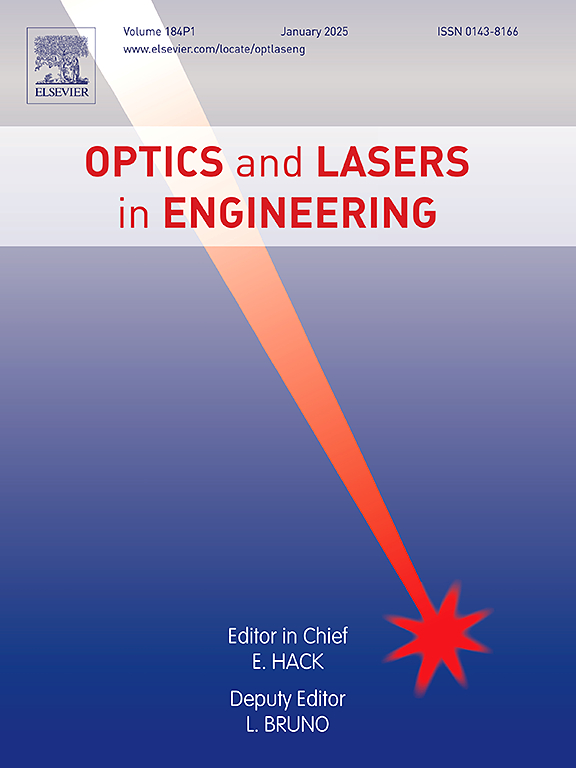基于相位强度混合编码的无附加模式绝对相位检索
IF 3.5
2区 工程技术
Q2 OPTICS
引用次数: 0
摘要
本文提出了一种基于相位-强度混合编码的绝对相位检索方法。该方法无需添加任何额外图案即可稳健地检索绝对相位。首先,采用四步移相轮廓仪来分辨相位,第一和第三正弦波条纹图案正好互补,用于分辨相位和植入编码字。然后,设计出三级四位编码字来编码所有的条纹阶次,并将其分为两半。前半部分的码字覆盖第一个移相图案相应周期内的前半部分正弦波图案,而后半部分的码字则覆盖互补图案相应周期内的后半部分正弦波图案。因此,这对互补正弦波图案是相位-强度混合编码图案的复合体。当这对图案和其余的移相图案投射到被测物体上时,相应的变形图案就会被摄像头捕捉到。此外,还提出了一种边缘阶次分割算法,以实现码元校正,并成功提取出完整的码元和完整的正弦变形图案。因此,可以解决由被测物体高度引起的相位缠绕问题,并从查找表中解码出正确的条带阶次,从而检索出绝对相位。实验结果表明了所提方法的可行性和有效性。实验结果表明,在不增加任何额外图案的情况下,编码字更加稳健,重建精度也得到了有效提高。当可用的条纹阶数较多时,可以减少投影图案的数量。此外,还能更容易地找到码字的起始位,并有效降低码字邻近效应。本文章由计算机程序翻译,如有差异,请以英文原文为准。
Absolute phase retrieval based on phase-intensity hybrid encoding without any additional pattern
An absolute phase retrieval method based on phase-intensity hybrid encoding is proposed. It can robustly retrieve the absolute phase without adding any additional pattern. At first, four-step phase-shifting profilometry is applied to resolve the phase, and the first and the third sinusoidal fringe patterns just complementary to each other are used for both phase resolving and implantation of codewords. Then three-level four-bit codewords are designed to encode all the fringe orders and are separated into two halves. The first half codeword covers the first half sinusoidal pattern in the corresponding period of the first phase-shifting pattern, while the second half codeword covers the second half sinusoidal pattern on the corresponding period of the complementary pattern. So, this pair of complementary sinusoidal patterns are compound of the phase-intensity hybrid encoding patterns. When this pair of patterns and the remaining phase-shifting patterns are projected onto the measured object, the corresponding deformed patterns are captured with camera. And a fringe order segmentation algorithm is also proposed to achieve codeword correction and to extract both the complete codewords and the complete sinusoidal deformed patterns successfully. So, the wrapped phase caused by the height of the measured object can be resolved and the codewords can be decoded to be the correct fringe order from the lookup table so as to retrieve the absolute phase. The experimental results show the feasibility and validity of the proposed method. It reveals the codewords are more robust and the reconstruction accuracy is improved effectively without adding any additional pattern. The number of projected patterns can be reduced when there are more fringe orders available. It is also easier to locate the beginning bit of codeword and efficiently reduce codeword proximity effects.
求助全文
通过发布文献求助,成功后即可免费获取论文全文。
去求助
来源期刊

Optics and Lasers in Engineering
工程技术-光学
CiteScore
8.90
自引率
8.70%
发文量
384
审稿时长
42 days
期刊介绍:
Optics and Lasers in Engineering aims at providing an international forum for the interchange of information on the development of optical techniques and laser technology in engineering. Emphasis is placed on contributions targeted at the practical use of methods and devices, the development and enhancement of solutions and new theoretical concepts for experimental methods.
Optics and Lasers in Engineering reflects the main areas in which optical methods are being used and developed for an engineering environment. Manuscripts should offer clear evidence of novelty and significance. Papers focusing on parameter optimization or computational issues are not suitable. Similarly, papers focussed on an application rather than the optical method fall outside the journal''s scope. The scope of the journal is defined to include the following:
-Optical Metrology-
Optical Methods for 3D visualization and virtual engineering-
Optical Techniques for Microsystems-
Imaging, Microscopy and Adaptive Optics-
Computational Imaging-
Laser methods in manufacturing-
Integrated optical and photonic sensors-
Optics and Photonics in Life Science-
Hyperspectral and spectroscopic methods-
Infrared and Terahertz techniques
 求助内容:
求助内容: 应助结果提醒方式:
应助结果提醒方式:


